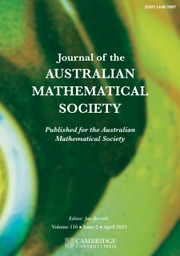Crossref Citations
This article has been cited by the following publications. This list is generated based on data provided by Crossref.
Clote, P.
and
Kranakis, E.
1989.
Boolean functions, invariance groups and parallel complexity.
p.
55.
Kovács, L. G.
1989.
Wreath decompositions of finite permutation groups.
Bulletin of the Australian Mathematical Society,
Vol. 40,
Issue. 2,
p.
255.
Delandtsheer, Anne
1989.
Line-primitive Automorphism Groups of Finite Linear Spaces.
European Journal of Combinatorics,
Vol. 10,
Issue. 2,
p.
161.
Praeger, Cheryl E.
1989.
Highly Arc Transitive Digraphs.
European Journal of Combinatorics,
Vol. 10,
Issue. 3,
p.
281.
Praeger, Cheryl E.
1990.
Groups—Canberra 1989.
Vol. 1456,
Issue. ,
p.
63.
Pálfy, P.P.
and
Saxl, J.
1990.
Congruence lattices of finite algebras and factorizations of groups.
Communications in Algebra,
Vol. 18,
Issue. 9,
p.
2783.
Liebeck, Martin W.
and
Saxl, Jan
1991.
On point stabilizers in primitive permutation groups.
Communications in Algebra,
Vol. 19,
Issue. 10,
p.
2777.
Kleidman, Peter B.
and
Wales, David B.
1991.
The projective characters of the symmetric groups that remain irreducible on subgroups.
Journal of Algebra,
Vol. 138,
Issue. 2,
p.
440.
Colte, Peter
and
Kranakis, Evangelos
1991.
Boolean Functions, Invariance Groups, and Parallel Complexity.
SIAM Journal on Computing,
Vol. 20,
Issue. 3,
p.
553.
Praeger, Cheryl E.
1991.
Kronecker classes of field extensions of small degree.
Journal of the Australian Mathematical Society. Series A. Pure Mathematics and Statistics,
Vol. 50,
Issue. 2,
p.
297.
Wang, Jie
1992.
Primitive permutation groups with a sharply 2-transitive subconstituen of prime degree*.
Communications in Algebra,
Vol. 20,
Issue. 3,
p.
923.
Macpherson, Dugald
1993.
Finite and Infinite Combinatorics in Sets and Logic.
p.
249.
Fried, Michael D.
Guralnick, Robert
and
Saxl, Jan
1993.
Schur covers and Carlitz’s conjecture.
Israel Journal of Mathematics,
Vol. 82,
Issue. 1-3,
p.
157.
Praeger, Cheryl E.
1994.
Kronecker classes of fields and covering subgroups of finite groups.
Journal of the Australian Mathematical Society. Series A. Pure Mathematics and Statistics,
Vol. 57,
Issue. 1,
p.
17.
Camina, A. R.
1994.
A survey of the automorphism groups of block designs.
Journal of Combinatorial Designs,
Vol. 2,
Issue. 2,
p.
79.
Baddeley, Robert W.
1994.
Images of commutator MAPS.
Communications in Algebra,
Vol. 22,
Issue. 8,
p.
3023.
Xu, Ming-Yao
1994.
Vertex-primitive digraphs of prime-power order are hamiltonian.
Discrete Mathematics,
Vol. 128,
Issue. 1-3,
p.
415.
Ivanov, A. A.
1994.
Investigations in Algebraic Theory of Combinatorial Objects.
Vol. 84,
Issue. ,
p.
283.
Delandtsheer, Anne
1994.
Classifications of finite highly transitive dimensional linear spaces.
Discrete Mathematics,
Vol. 129,
Issue. 1-3,
p.
75.
Huiling, Li
1995.
On block-transitive 2 - (ν, 4, 1) designs.
Journal of Combinatorial Theory, Series A,
Vol. 69,
Issue. 1,
p.
115.

